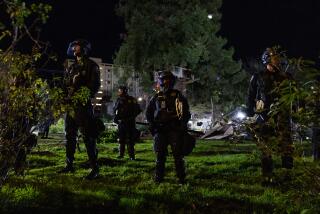Cudahy park project languishes 7 years after state grant awarded
Packed into 1.2-square miles next to the 710 Freeway and its rumbling trucks, Cudahy is one of the poorest, most densely populated cities in California. Its 25,000 residents live in rows of apartments, a concrete landscape broken up by just three small parks, one of which was long closed because of contamination.
So when the state offered Cudahy $2.5 million in 2004 to expand one of the parks, it seemed like a windfall.
But over the next seven years, it has become a civic embarrassment that some officials say raises questions about the competency of the leadership in City Hall.
No property has been acquired, no equipment bought and not a single tree planted. Frustrated state officials repeatedly asked the city about the park grant but seldom got a response. The city spent nearly $160,000 on initial planning, but there is little to show for it.
The city’s inability to complete the one-acre park eventually prompted the state to demand that the money be returned.
“I’m just as disgusted as you are,” Mayor Josue Barrios said. “It’s incompetence.”
State officials said that early on they thought the city’s handing of the Clara Street park expansion was unusual. Then-City Manager George Perez and consultant Michael Ramirez ignored most emails and letters from California State Parks, which had asked for an accounting of the bond money and a progress report on the park, according to documents obtained by The Times.
Ramirez conceded to state officials that the city had been “avoiding them,” according to a Jan. 30, 2009, email from one parks official to another. Ramirez declined to talk to The Times.
Cudahy never got far enough along on the project to obtain the entire $2.5 million from the state, receiving only a $250,000 advance.
The state sent an auditor in 2009 to check on that funding and discovered that the city had spent $159,750, but that only $37,750 was considered a legitimate expenditure. Of those funds, $147,000 went to Ramirez for consulting.
Even after the audit, Perez failed to respond to the state’s demands to return the funds. State Parks sent Perez a letter in February 2010 calling this “an urgent matter.” The letter said that the city was supposed to have spent the $250,000 within six months of receiving it and that the state wanted the cash back in 30 days.
Three months later, the state sent a follow-up letter. “It is critical that your office respond to the outstanding advance, interest, and audit report regarding the above state-funded project,” it said. State Parks “has made numerous attempts to contact you and your office by telephone and letter over several years.”
By 2011, the amount the city owed the state had ballooned to $376,798 because of interest, and the state threatened legal action. In a letter last May, city finance director Mellie D. Deano claimed Cudahy owed only $240,114 and said she was enclosing a check to settle the matter.
The check never arrived.
Patty Keating, chief of State Parks’ Office of Grants and Local Services, said no other government entity has owed her agency money for so long.
“Only a few projects come to my attention,” Keating said. “This one did.”
The city’s point man on the project was Perez, a former city janitor-turned-councilman, who, without administrative experience or a college degree, was appointed city manager in 2000.
The council fired Perez in March with little explanation and then terminated longtime City Atty. David Olivas and placed the city clerk and human resources director on administrative leave, a group Barrios called “the whole posse.”
Barrios, who has been a city councilman the last two years, said he didn’t know anything about the park until Assemblyman Ricardo Lara (D-Bell Gardens) called him in March to congratulate him on being appointed mayor. Lara asked him how the park was going.
What park? Barrios replied.
Perez’s attorney, Stanley Friedman, said his client blamed problems on the state changing its contacts with the city. He said that council members were consulted throughout and that “blaming Mr. Perez for anything is because he’s no longer there and is an easy target.”
Luis Garcia, a longtime resident who once ran for City Council, said that besides law enforcement, a city’s most important duty is to provide parks and open space.
“It’s an area where people can get away from their compacted living conditions, and it allows the city to run youth programs” that help keep kids from joining gangs, he said. “This shows you the leadership in the city is very poor.”
The application for the park grant said 26.4% of the city’s population lived below the poverty line. There was only one soccer field in the city, the application said, and Cudahy’s largest park was so contaminated it couldn’t be fully used for five years.
The mayor wasn’t the only person who said he was unaware the city was failing to take advantage of the grant. Angel Peralta, who had served as the city’s director of parks and recreation, said he was never told the grant was about to expire. Neither was Saul Bolivar, the city’s director of community development.
The four council members besides Barrios refused to respond to Times phone calls, emails and visits to their homes and a City Council meeting. The veteran council members said they would talk to The Times only if their public relations consultant attended, and set up a meeting but then canceled it.
All has not been lost for Cudahy. Lara said that when his staff found out the grant was set to expire in June, it called State Parks. “The department was hesitant to extend the allocation because they had no confidence in the city management,” he said.
Lara sponsored legislation extending the deadline, and Cudahy now has until June 30, 2015, to complete the project. And the city has returned most of the advance to Sacramento.
This time the check arrived.
More to Read
Start your day right
Sign up for Essential California for news, features and recommendations from the L.A. Times and beyond in your inbox six days a week.
You may occasionally receive promotional content from the Los Angeles Times.







